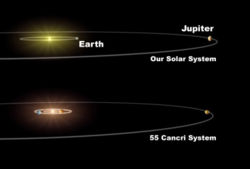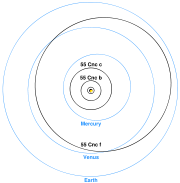55 Cancri
2008/9 Schools Wikipedia Selection. Related subjects: Space (Astronomy)
| Observation data Epoch J2000.0 |
|
|---|---|
| Constellation ( pronunciation) |
Cancer |
| Right ascension | 08h 52m 35.8s |
| Declination | +28° 19′ 51″ |
| Apparent magnitude (V) | 5.95 |
| Characteristics | |
| Spectral type | G8V / M3.5-4V |
| U-B colour index | 0.65 / 1.66 |
| B-V colour index | 0.86 / 1.21 |
| Astrometry | |
| Radial velocity (Rv) | 27.3 km/s |
| Proper motion (μ) | RA: -485.46 mas/ yr Dec.: -234.40 mas/ yr |
| Parallax (π) | 79.80 ± 0.84 mas |
| Distance | 40.9 ± 0.4 ly (12.5 ± 0.1 pc) |
| Absolute magnitude (MV) | 5.46 / 12.66 |
| Details | |
| Mass | 0.95±0.1 / 0.13 M☉ |
| Radius | 0.96 / 0.30 R☉ |
| Luminosity | 0.63 / 0.0076 L☉ |
| Temperature | 5250 K |
| Rotation | 42.2 d |
| Age | 4.5×109 years |
| Database references | |
| SIMBAD | data |
| Other designations | |
|
Rho1 Cancri, Gliese 324, BD +28°1660, HD 75732
|
|
55 Cancri (pronounced /ˈkæŋkraɪ/ or /ˈkæŋkriː/), also known as Rho1 Cancri or abbreviated as 55 Cnc, is a binary star system approximately 41 light-years away in the constellation of Cancer. The primary star of the system (designated 55 Cancri A) is a solar twin yellow dwarf star and a smaller red dwarf star (designated 55 Cancri B). The two components are separated by over 1000 times the distance from the Earth to the Sun.
As of 2008, five extrasolar planets are known in orbit around 55 Cancri A. Four of the planets are comparable to Jupiter in mass, while the innermost planet has a mass similar to that of Neptune. The 55 Cancri system was the first known five-planet extrasolar planetary system. 55 Cancri A is ranked 63rd in the list of top 100 target stars for the NASA Terrestrial Planet Finder mission.
Name
55 Cancri (the star's Flamsteed designation) is seen more often than its Bayer designation Rho1 Cancri. The latter is used by those who feel that it should be preferred to the Flamsteed number — as is usually done (e.g., Tau Bootis is almost never called "4 Bootis"). But in this case the superscript in "Rho1" makes the Bayer designation rather cumbersome, so that 55 Cancri is the more commonly used name for this star.
Distance and visibility
The 55 Cancri system is located fairly close to our solar system: the Hipparcos astrometry satellite measured the parallax of 55 Cancri A as 79.80 milliarcseconds, corresponding to a distance of 12.5 parsecs. 55 Cancri A has an apparent magnitude of 5.95, making it visible through binoculars. It is just visible to the naked eye under very dark skies. The red dwarf 55 Cancri B is of the 13th magnitude and only visible through a telescope.
System components
The primary star 55 Cancri A is a yellow dwarf star of main sequence spectral type G8V. It is smaller in radius and slightly less massive than our Sun, and so is cooler and less luminous. The star has little or no variability and only low emission from its chromosphere.
55 Cancri A is more enriched than our sun in elements heavier than helium, with 186% the solar abundance of iron; it is therefore classified as a rare "super metal-rich" (SMR) star. This abundance of metal makes estimating the star's age and mass difficult, as evolutionary models are less well defined for such stars. One estimate based on chromospheric activity suggests an age of around 5,500 million years.
A hypothesis for the high metal content in SMR dwarf stars is that material enriched in heavy elements fell into the atmosphere from a protoplanetary disk. This would pollute the star's external layers, resulting in a higher than normal metallicity. The lack of a deep convection zone would mean that the outer layers would retain higher abundance ratios of these heavy elements.
Observation of 55 Cancri A in the submillimeter region of the spectrum have thus far failed to detect any associated dust. The upper limit on emissions within 100 AU of this star is about 850 mJy, at a wavelength of 850 μm. This limits the total mass of fine dust around the star to less than 0.01% of the Earth's mass. Of course, this does not exclude the existence of an asteroid belt or a Kuiper belt equivalent.
55 Cancri B is a red dwarf star located at an estimated distance of 1065 AU from the primary star, and is much less massive and luminous than our Sun. Despite their wide separation, the two stars appear to be gravitationally bound, as they share a common proper motion. There are indications that component B may itself be a double star, though this is by no means certain.
Planetary system
In 1997, the discovery of a 51 Pegasi-like planet orbiting 55 Cancri A was announced, together with the planet of Tau Boötis and the inner planet of Upsilon Andromedae. The planet was discovered by measuring the star's radial velocity, which showed a periodicity of around 14.7 days corresponding to a planet at least 78% of the mass of Jupiter. This planet was designated 55 Cancri b, though to distinguish it from the star 55 Cancri B it is occasionally referred to as 55 Cancri Ab. The radial velocity measurements still showed a drift unaccounted-for by this planet, which could be explained by the gravitational influence of a more distant object.
In 1998 the discovery of a possible dust disk around 55 Cancri A was announced. Calculations gave the disk radius at least 40 AU, similar to the Kuiper belt in our solar system, with an inclination of 25° with respect to the plane of the sky. However, the discovery could not be verified and was later deemed to be spurious, caused instead by background radiation.

After making further radial velocity measurements, a planet orbiting at a distance of around 5 AU was announced in 2002. This planet received the designation 55 Cancri d. At the time of discovery, the planet was thought to be in an orbit of mild eccentricity (close to 0.1), however this value was increased by later measurements. Even after accounting for these two planets, a periodicity at 43 days remained, possibly due to a third planet. Measurements of the star suggested that this was close to the star's rotation period, which raised the possibility that the 43-day signal was caused by stellar activity. This possible planet received the designation 55 Cancri c.
In 2004 a Neptune-mass planet designated 55 Cancri e was announced in a 2.8-day orbit. This planet may either be a small gas giant or a large terrestrial planet. The measurements that led to the discovery of this planet also confirmed the existence of 55 Cancri c. In addition, astrometric measurements made by the Hubble Space Telescope led to an estimate of the inclination of the orbit of the outer planet: around 53° with respect to the plane of the sky. Assuming the system is coplanar, this means the true masses of the planets are around 25% greater than the lower limits measured by the radial velocity method.
In 2005 the existence of planet e was questioned by Jack Wisdom in a reanalysis of the data. According to him, instead of the 2.8-day planet there is a planet with a mass similar to that of Neptune in a 261-day orbit (corresponding to 0.77 AU in distance). This analysis has been partially confirmed in November 2007 - a planet designated 55 Cancri f with half the mass of Saturn was announced in a 260-day orbit, right in 55 Cancri A's habitable zone. The planet itself is not thought to be conducive to life, but hypothetical moons in principle could maintain at least microbial life.
| Companion (in order from star) |
Mass ( MJ) |
Semimajor axis ( AU) |
Orbital period (days) |
Eccentricity |
|---|---|---|---|---|
| e | >0.034 ± 0.0036 | 0.038 ± 10−6 | 2.81705 ± 0.0001 | 0.07 ± 0.06 |
| b | >0.824 ± 0.007 | 0.115 ± 0.0001 | 14.65162 ± 0.0007 | 0.014 ± 0.008 |
| c | >0.169 ± 0.008 | 0.240 ± 4.5×10−5 | 43.93 ± 0.021 | 0.086 ± 0.052 |
| f | >0.144 ± 0.04 | 0.781 ± 0.007 | 260 ± 1.1 | 0.2 ± 0.2 |
| d | >3.835 ± 0.08 | 5.77 ± 0.11 | 5218 ± 230 | 0.025 ± 0.03 |
METI message
There was a METI message sent to 55 Cancri. It was transmitted from Eurasia's largest radar — 70-meter Eupatoria Planetary Radar. The message was named Cosmic Call 2, it was sent on July 6, 2003, and it will arrive at 55 Cancri in May 2044.

